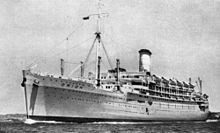RMS Orion

RMS Orion, State Library of Queensland
|
|
| History | |
|---|---|
| Name: | RMS Orion |
| Operator: | Orient Steam Navigation Company |
| Builder: | Vickers Armstrong, Barrow-in-Furness, Lancashire |
| Launched: | 7 December 1934 |
| Completed: | August 1935 |
| Fate: | Broken for scrap at Antwerp, 1963 |
| General characteristics | |
| Class and type: | Passenger liner |
| Tonnage: | 23,371 GRT |
| Length: | 665 ft (203 m) |
| Beam: | 82 ft (25 m) |
| Draught: | 30 ft 8 in (9.35 m) |
| Propulsion: |
|
| Speed: | 21 kn (39 km/h; 24 mph) |
| Capacity: |
|
| Crew: | 466 (later 565) |
RMS Orion was an ocean liner launched by the Orient Steam Navigation Company in 1934 and retired from the water in 1963 after carrying about 500,000 passengers. A 23,371 ton passenger ship, the Orion was built to carry 486 first class, 653 tourist class and 466 crew passengers from Europe through the Pacific to Australia. The construction of the ship was documented in Paul Rotha's 1935 film 'Shipyard'.
The vessel's sister ship was Orcades, launched in 1937.
Orion was an enlarged version of SS Orontes, and the first single funnel ship to be built for the Orient Line since 1902. She also had a single mast, giving her a very different appearance to her predecessors. She was the first ship to be painted in the Orient Line's livery with a corn coloured hull.
Her accommodation was originally designed for 486 First Class and 653 Tourist Class passengers, with a crew of 466. When sailing on cruise voyages she accommodated 600 passengers in a single class.
Orion was called "A landmark in the evolution of the modern liner" by the Architectural Review. Previous liners had adopted the cloistered and formally decorated styles of interior designing found in the wealthy homes of England, however, Brian OʼRorke, the New Zealand born designer in charge of Orion's interior, recognized the need to adapt to the tropical and oceangoing conditions of life aboard ship. The result was an open air layout that made use of removable and folding walls, sliding glass doors, and relatively enormous promenade decks to keep cooling breezes flowing through spaces passengers could relax in. Rooms without access to the deck of the boat were also made to feel breezy by being as light and uncluttered as possible. Furnishings were chosen for their clean lines, wood given matte finishes, and columns left unadorned. Going past just being unadorned, the chromium and bakelite materials used extensively throughout the ship meant surfaces were more resistant to the effects of sea air, a first in liners. This was a new type of functional interior that could be linked to the functionality of a shipʼs exterior. Orion was also the first British ship to be fitted with air conditioning, though this was originally confined to the dining rooms.
...
Wikipedia
